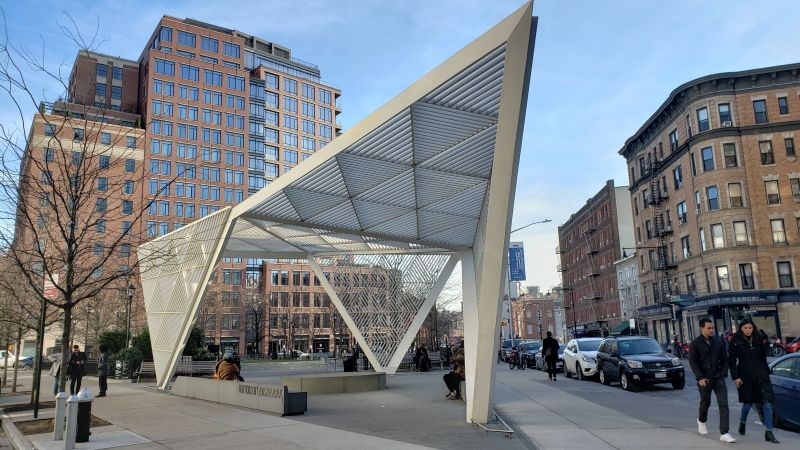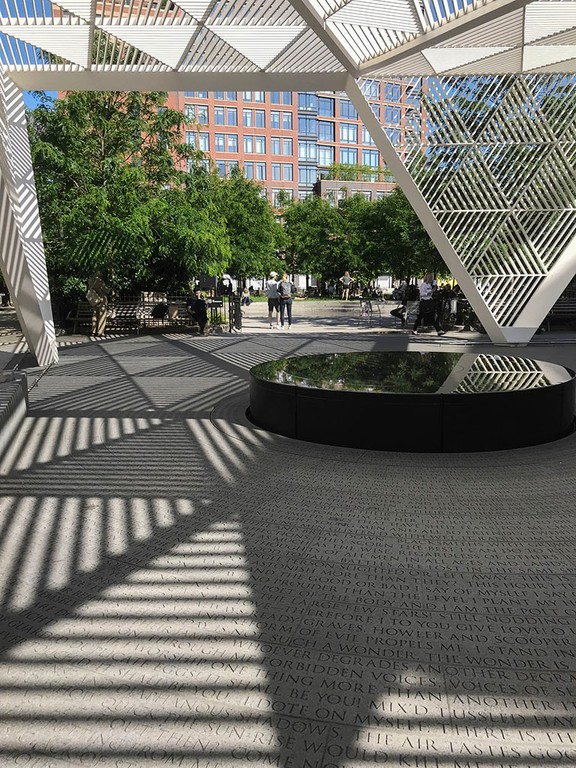New York City AIDS Memorial
Introduction
Text-to-speech Audio
Images
New York City AIDS Memorial

A view from inside the memorial

Backstory and Context
Text-to-speech Audio
In the 1980s and early 1990s, New York City was the epicenter of the HIV/AIDS crisis in the United States. In 1986, public health officials estimated that over half of all gay men and three-fifths of all intravenous drug users living in the city were infected with HIV (the human immunodeficiency virus), the virus that leads to AIDS (acquired immune deficiency syndrome). By the end of the following year, one in sixty-one New York City women giving birth had the virus. By the end of the 1980s, AIDS had become the leading cause of death among men ages twenty-five to forty-four and Black women ages fifteen to forty-four living in the city. Since the early 1980s, AIDS has claimed the lives of more than 100,000 New York City residents.
In early 2011, urban planners Christopher Tepper and Paul Kelterborn founded the New York City AIDS Memorial, which is now a 501 (c)(3) non-profit group. The two men were struck by the fact that, three decades after the first New Yorker died from the disease, the city still did not have a highly visible, public AIDS memorial. Later that same year, with the help of Architectural Record and Architizer, the foundation launched an international design competition. Michael Arad, the designer of the National September 11 Memorial, oversaw the effort. After reviewing nearly five hundred design proposals, the foundation selected the one submitted by studio ai architects, a Brooklyn architectural firm.
A tremendous amount of thought went into the selection of a site for the memorial. In the end, the foundation chose a small triangular park in Greenwich Village, mostly due to its significance to the history of the HIV/AIDS crisis in the city. The park was once part of the former St. Vincent’s Hospital complex. Early in the AIDS crisis, the disease disproportionately affected gay men. At the time, large gay communities existed in the West Village and Chelsea neighborhoods that surrounded St. Vincent’s Hospital. In response, the hospital established the first AIDS ward in the city (and second in the entire U.S.) in 1984. In addition, the park is within a few blocks of the LGBT Community Center on West Thirteenth Street, where ACT-UP was founded in 1987, the first headquarters of Gay Men’s Health Crisis, and the former office of Dr. Joseph Sonnabend, who pioneered community-based research trials for the first AIDS medications. In 2010, St. Vincent’s Hospital declared bankruptcy and closed. Rudin Management, a Manhattan real estate conglomerate, purchased the complex, demolished it, and erected seven high-rises filled with luxury condominiums on the property. A small corner of the property was transformed into a public park, which the City of New York acquired in 2017.
Just over five years after the design competition was launched, the memorial was dedicated on World AIDS Day (December 1) 2016 during a public ceremony in the newly-renamed New York City AIDS Memorial Park at St. Vincent’s Triangle. It consists of an eighteen-foot white triangular steel canopy that hovers over a granite water fountain and benches. Verses from Walt Whitman’s 1855 poem “Song of Myself” are engraved in a circular pattern in the granite pavement, the work of visual artist Jenny Holzer. The memorial functions not only as a gateway to the park, but also, more importantly, as a place for visitors to reflect on those lost to the disease.
Sources
"About the New York City AIDS Memorial." New York City AIDS Memorial. New York City AIDS Memorial, Inc. <https://www.nycaidsmemorial.org/about>.
"About the New York City AIDS Memorial Design." New York City AIDS Memorial. New York City AIDS Memorial, Inc. <https://www.nycaidsmemorial.org/design>.
Campbell, Alyson and Dirk Gindt, eds. Viral Dramaturgies: HIV and AIDS in Performance in the Twenty-First Century. Cham, Switzerland: Springer International Publishing, 2018.
"NYC AIDS Memorial Park at St. Vincent's Triangle." New York City Department of Parks and Recreation. The City of New York. Web. 10 December 2020 <https://www.nycgovparks.org/parks/nyc-aids-memorial-park-at-st-vincent-s-triangle/history>.
https://www.nycgovparks.org/parks/nyc-aids-memorial-park-at-st-vincent-s-triangle/history
https://alinaoswald.com/2019/06/11/what-to-photograph-the-nyc-aids-memorial/
